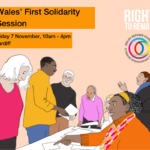
On the 2nd March 2023, Praxis, the Institute for Public Policy Research and Greater Manchester Immigration Aid Unit published their report on the experiences of people on the 10 year route to settlement. This new report outlines the damage caused by the 10 year route to settlement. You can read the full report here.
Recently, we attended a conference organised by Migrant Voice on the challenges faced by people on this route to settlement. This report echoes many things we heard at the conference. Read our blog post about that event here.
This short blog outlines the key points highlighted in the report.
What is the 10 year route?
The ten year route to settlement was introduced in 2012 and is for people who have very strong ties to the UK to get permission to stay here permanently. You might apply on the ten year route if you have children who are British and have lived in the UK for 7 years, or you have lived in the UK for a substantial period of your life already. The route outlines how the majority of people on this route are women, parents and caregivers, as well as Black, South Asian people from commonwealth countries.
An applicant on the ten year route to settlement is required to apply for limited leave to remain every 30 months (2.5 years) for 10 years. This means that you will have to apply 4 times during the 10 year period. Only after you have completed the 10 year period, and have renewed your visa 4 times, can you apply for indefinite leave to remain in the UK. Missing an application or making a single mistake during this 10 year period will mean you have to re-start the 10 year route from the beginning.
The report highlights the hugely detrimental effects this process has on the mental health of applicants: 80% reported that their mental health was negatively affected as a direct result.
This entire process is hugely costly, at about £13,000 per person. The report highlights how these costs have forced some families to make decisions about which parent or child should make the application. There is limited access to fee waivers (where the Home Office agrees that you don’t have to pay the fee). The report explains that some people might not be aware that they are eligible for a fee waiver, meaning that they go into debt to fund the application.
Working during this process can be very difficult – particularly because the Home Office does not issue applicants with physical proof of having submitted an application. This means that some employers who are anxious at the prospect of employing someone without leave to remain have ended employment contracts for people on the 10-year route. Others are pushed into exploitative work. The charity RAMFEL is challenging the government on the Home Office’s refusal to issue documents to migrants who are waiting for a visa renewal. Read more about this legal challenge here.
People on the 10-year route to settlement are also given an NRPF (No Recourse to Public Funds) condition on their visa, which means they are not able to access welfare benefits. This is why over half of applicants on the 10 year route struggle to afford food. It is possible to apply for a change of conditions to have the NRPF condition lifted, but this application is complicated and many people do not receive help to do this. Furthermore, this NRPF condition is automatically imposed on every visa, so families often have to apply to have the NRPF condition lifted multiple times during the 10 year period.
What is next?
In recent years, routes to settlement have become longer, more complicated, and more expensive. We know there is a lack of immigration lawyers, and a lack of legal information available for these types of applications: unlike asylum advice, there is no legal aid for immigration advice.
This is why we are working on strengthening the immigration sections of our Toolkit, to support people on these kinds of routes to settlement. There are an increasing number of people on these long routes to settlement, and that is why this work is urgently needed.
This report outlines a number of key recommendations to change the 10 year route, including shortening the length and reducing the cost.
Here are three ways you can take action today:
















Re: 10 year route:
I believe it is (sometimes?) possible to switch from the 10 year route to a 5 year route when making the first application to extend after 30 months.
Thanks for your comment Barry. Yes it is possible to switch from the 10 year route to the 5 year route in certain circumstances. To qualify under the 5 year route, you must have lived in the UK lawfully and continuously on a visa for 5 years, as well as meeting other financial requirements. In some cases, it can be better to stay on the 10 year route however, as only time spent in the UK within the rules of the 5 year rule can count towards settlement.